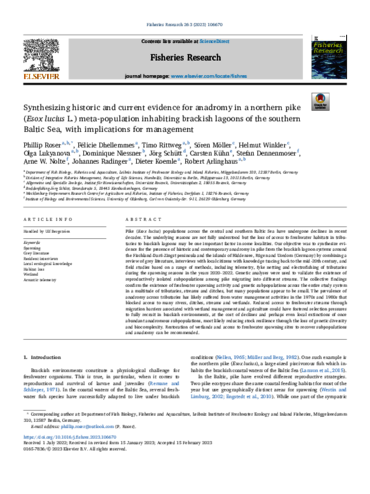Pike (Esox lucius) populations across the central and southern Baltic Sea have undergone declines in recent decades. The underlying reasons are not fully understood but the loss of access to freshwater habitats in tributaries to brackish lagoons may be one important factor in some localities. Our objective was to synthesize evidence for the presence of historic and contemporary anadromy in pike from the brackish lagoon systems around the Fischland-Darß-Zingst peninsula and the islands of Hiddensee, Rügen and Usedom (Germany) by combining a review of grey literature, interviews with local citizens with knowledge tracing back to the mid-20th century, and field studies based on a range of methods, including telemetry, fyke netting and electrofishing of tributaries during the spawning seasons in the years 2020–2022. Genetic analyses were used to validate the existence of reproductively isolated subpopulations among pike migrating into different streams. The collective findings confirm the existence of freshwater spawning activity and genetic subpopulations across the entire study system in a multitude of tributaries, streams and ditches, but many populations appear to be small. The prevalence of anadromy across tributaries has likely suffered from water management activities in the 1970s and 1980s that blocked access to many rivers, ditches, streams and wetlands. Reduced access to freshwater streams through migration barriers associated with wetland management and agriculture could have fostered selection pressures to fully recruit in brackish environments, at the cost of declines and perhaps even local extinctions of once abundant anadromous subpopulations, most likely reducing stock resilience through the loss of genetic diversity and biocomplexity. Restoration of wetlands and access to freshwater spawning sites to recover subpopulations and anadromy can be recommended.
Synthesizing historic and current evidence for anadromy in a northern pike (Esox lucius L.) meta-population inhabiting brackish lagoons of the southern Baltic Sea, with implications for management
Project Boddenpike , Peer-reviewed

Roser, P., Dhellemmes, F., Rittweg, T., Möller, S., Winkler, H., Lukyanova, O., Niessner, D., Schütt, J., Kühn, C., Dennenmoser, S., Nolte, A.W., Radinger, J., Koemle, D., Arlinghaus, R. 2023. Synthesizing historic and current evidence for anadromy in a northern pike (Esox lucius L.) meta-population inhabiting brackish lagoons of the southern Baltic Sea, with implications for management. Fisheries Research, 263, 106670.
Published
: 2023
Appeared in
: Fisheries Research, 263, 106670
